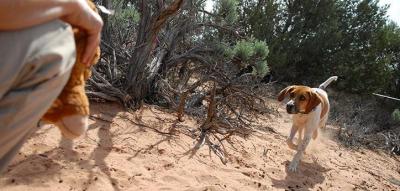
How to Teach a Dog to Come
Teaching your dog to come when called is a great safety tool to have in place. It can be used in emergency situations if your dog dashes out the door, slips their collar, or is off leash on a hike and is approached by a dog or other animal. Teaching your dog recall might save end up saving their life. Use the following steps to practice recall training for dogs.
Teaching a dog to come
Start the recall training in a quiet area with few distractions. Grab high-value treats, a long leash, and a clicker.
- Attach the leash to your dog’s collar, and make sure there is plenty of slack. Move backward away from your dog. When they are moving toward you, say “come” in a fun tone; you might need to reel them in with the leash to encourage them to come to your front. Click the clicker and reward your dog with a treat or praise/petting when they come to you.
- Continue step 1 until your dog immediately comes right up to you with the cue. You might need to make it more of a game for your dog if they are struggling; lightly jog backward so they need to catch up to you and get excited!
- Once you can cue “come” successfully, you can start to practice with more distance. Stand several feet away and say “come.” You might need to say your dog’s name first to get their attention. Continue making more space between you and your dog and offering the cue until they have it mastered in a quiet environment. Then, you are ready to move on to more distractions.
Proofing dog recall training
Proofing in dog training means teaching the dog to generalize the behavior in different contexts. For the “come” command this is especially important because you’ll want your dog to have good recall in different locations and with various distractions.
Continue your training someplace with few distractions, such as your backyard. Then, gradually move to more distracting areas with different sounds, smells, other people, other dogs, etc.
Home starts with you
If necessary, move back a step in the training plan until your dog is consistently coming to you no matter what’s going on around them. Be sure to keep your dog on leash when in a public place or a space that’s not closed in until you are certain your dog will come on command.
Also, have other people work on recall training with your dog. Have them start from step 2 in the training plan, and work up to recall in different scenarios.
Tips for when your dog won't come
Teaching a dog to come is generally easy, but it can be difficult to maintain consistently. Even a dog who has gone through the whole training process sometimes won’t come on cue.
Be careful not to “poison” the cue. If the cue “come” always means that the fun stops, your dog will likely stop coming. Also, make sure you are using the same cue consistently (i.e., always say “come” rather than variations of it, such as “come here” or “c’mon”).
Don’t rush; take the recall training process at your dog’s speed. If necessary, you can create intermediate steps in the process to more gradually advance.
